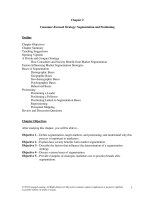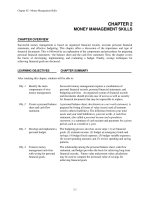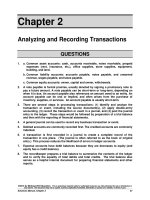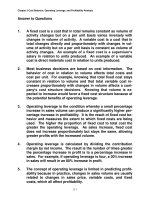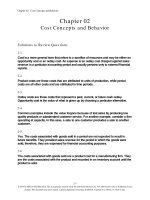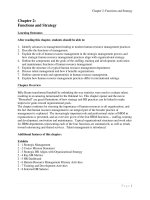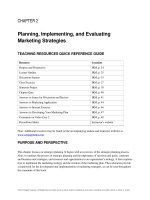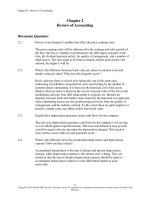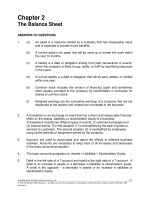Test bank and solution manual for ch02 FUnctions and strategy (2)
Bạn đang xem bản rút gọn của tài liệu. Xem và tải ngay bản đầy đủ của tài liệu tại đây (299.98 KB, 17 trang )
Chapter 2: Functions and Strategy
Chapter 2:
Functions and Strategy
Learning Outcomes
After reading this chapter, students should be able to:
1. Identify advances in management leading to modern human resource management practices.
2. Describe the functions of management.
3. Explain the role of human resource management in the strategic management process and
how strategic human resource management practices align with organizational strategy.
4. Outline the components and the goals of the staffing, training and development, motivation
and maintenance functions of human resource management.
5. Explain the structure of a typical human resource management department.
6. Discuss talent management and how it benefits organizations.
7. Outline current trends and opportunities in human resource management.
8. Explain how human resource management practices differ in international settings.
Chapter Overview
Billy Beane transformed baseball by rethinking the way statistics were used to evaluate talent,
resulting in an amazing turnaround for the Oakland A's. This chapter opener and the movie
"Moneyball" are great illustrations of how strategy and HR practices can be linked to make
impressive gains toward organizational goals.
The chapter continues by stressing the importance of human resources to all organizations, and
the fact that human resource management is an integral part of the broader practice of
management is explained. The increasingly important role and professional status of HRM in
organizations is presented, and an overview given of the four HRM functions -- staffing, training
and development, motivation and maintenance. Typical organizational structures and work roles
for HRM departments representing each of the four functions are summarized, as well as trends
toward outsourcing and shared services. Talent management is introduced.
Additional features of this chapter:
Exhibits
2 - 1 Strategic Management
2 - 2 Costco Mission Statement
2 - 3 Strategic HR Aligns with Organizational Strategy
2 - 4 Key HR Metrics
2 - 5 HR Dashboard
2 - 6 Human Resource Management Primary Activities
2 - 7 Training and Development Activities
2 - 8 Selected HR Salaries
Page 1
Chapter 2: Functions and Strategy
Boxed Features
These features are located within the text and address current issues in HRM within the context
of the relevant learning outcomes. They are short and thought provoking with thought questions
at the end providing a great opportunity to provide a break in class lecture to check student
understanding. Questions may be posed to students individually, in small groups, as quick
cooperative learning assignments or as large group discussions.
Diversity Topics - How Nike Does It page 35 Nike's mission statement is a bit
provocative at first, but it's a way to get student's attention.
Tips for Success: HRM Certification page 41 HR certification can open doorways for
those who take time (and money) to pursue it. The certifications of SHRM, HRCI and
ATD are explained.
Making Concepts Relevant in Your Classroom
In addition to the activities provided in the lecture notes, these suggested activities help students
apply chapter 2 concepts:
Introductory “Bingo”: Each box in a Bingo grid format can represent a personal
attribute or experience relevant to HR (e.g., “wants to work with people,” “is a business
major,” “speaks a foreign language”). Students mingle with each other, putting an
individual’s name in a box if the student matches the description. Each name can only be
used once. The first student to get six names across, down, or diagonally is the “winner”
of the Bingo game. This is a great ice-breaker. Box descriptions can be used as the basis
for an introductory discussion; e.g., you can discuss the nature of HR work, the education
required, the relevance of foreign languages, etc.
This is an excellent time to talk about HR career paths and the relevance of different
majors. The profession of HR has many career paths, and HR practitioners come from a
variety of academic and work backgrounds. In most introductory HR classes you will
have individuals from a variety of majors who often do not fully understand the
similarities, differences, and ways that different academic areas complement each other.
Consider assigning this as a brief interview of a local HR professional or member of their
employer’s HR organization.
If your school has a chapter of the Society for Human Resource Management (SHRM)
this is a good time to introduce students to the benefits of a professional association. If
you do not have a chapter, perhaps there may be a local chapter which welcomes students
at its meetings or which will provide a speaker who can give an overview of HR activities
in the area. Make sure students investigate student memberships, which usually have
discounted membership fees.
Page 2
Chapter 2: Functions and Strategy
Chapter Outline and Lecture Suggestions
Introduction
Slide 3
HR is a subset of the science and practice of management, but it is gaining in recognition
and importance as a valuable strategic partner.
HR skills are important to organizations of any size.
Evolution of Management
Slide 4
Learning Outcome 1: Identify advances in management leading to modern human
resource management practices.
Management has evolved significantly in the last 100 years from the view that workers
only had value for their physical labor to our modern system of laws and practices that
value talent.
Significant Advances in Management
Frederick Taylor and scientific management
Pioneered worker screening and training.
Productivity tracking.
Still used today in a variety of industries.
Hugo Munsterberg
Matching worker personality and abilities to jobs.
Improved testing, training and performance evaluation.
Mary Parker Follett
Emphasized organizations as communities.
Employee groups
Community involvement
Elton Mayo and Hawthorne Studies
Relationship of supervisor and work group influence productivity.
Informal work groups affect worker performance.
Functions of Management
Slide 5
Learning Outcome 2: Describe the functions of management.
Management achieves objectives of the organization with and through people. The major
responsibilities of managers are divided into four major functions.
Planning
Establishing objectives and determining what needs to be done to accomplish
them.
Strategic planning and strategic HRM are linked.
Organizing
Determining what activities must be completed to accomplish goals.
Page 3
Chapter 2: Functions and Strategy
Equipment
Work groups
Financial resources
Technology
Supplies
Services
Leading
Inspiring effort
Establishing and maintaining culture
Controlling
Monitoring activities
Measuring progress toward goals.
Comparing results to objectives.
The Role of HR in the Strategic Management Process
Slide 6
Learning Outcome 3: Explain how HRM aligns human resource management processes
and practices with organizational strategy.
Planning and strategy help organizations react quickly to changes in the external
environment and actions of competitors.
Competitive advantage is a unique quality of the organization that is hard for
competitors to imitate, such as a talented workforce.
Class Activity: Exhibit 2 -1 Strategic Management Process page 29 illustrates how the
strategic process starts with analysis, develops strategies and implements those strategies.
This is a great opportunity to look up mission statements for familiar companies, such as
your college or another popular enterprise and have students evaluate how well the steps
in the process are executed.
HRM Department Responsibilities
Transactional work
Payroll
Benefits
Tactical work
Performance coaching
Conflict resolution
Strategic work
Aligning HR functions to support goals and strategy
Slide 7
Strategic Analysis
Mission
Mission statements describe why the organization exists.
Basis for strategic goals.
Slide 9
Page 4
Chapter 2: Functions and Strategy
The chapter includes Google's mission statement. YouTube has many
short videos that illustrate Google's talent management initiatives.
Core Values and Culture
Core values are beliefs about behavior and ethics
Culture is how values are demonstrated on a daily basis, "the way we act
around here."
Work ethic
Dress
Speech
Humor
How outsiders are treated
Communicated and maintained through HRM activities:
Employment brand
Orientation
Discipline
Rewards
Analyze the Environment
SWOT Analysis looks at internal and external strengths and weaknesses.
Strengths - internal
Weaknesses - internal
Opportunities - external
Threats - external
Core competencies are unique skills and strengths of the organization.
Strategy Formulation
Slide 11
Corporate Level Strategy includes the organizational goals for the future.
Growth
Restructuring
Business Level Strategies involve building a competitive advantage for the
business unit.
Functional Strategies establish the way functional units support corporate level
strategy.
Strategy Implementation
Slide 12
HR designs jobs that support strategy with necessary KSAs:
Knowledge
Skills
Abilities
Strategic Human Resource Management establishes a connection between the
organizational goals and activities of employees.
HR activities and decisions aligned to support strategy:
Recruiting
Hiring
Onboarding
Page 5
Chapter 2: Functions and Strategy
Training
Performance management
Career planning
Development
Compensation
Benefits
Evaluating Results
Slide 13
An old management saying goes "What gets measured, gets done."
HRM metrics measure effectiveness of business and HRM practices.
Dashboards are visual displays that represent metrics and allow quick
interpretation.
Benchmarks are comparisons to metrics of other businesses.
Exhibit 2 - 4 Key HR Metrics on page 35 lists some key says that HR can
measure the results of important activities.
Exhibit 2 - 5 HR Dashboard on page 35 illustrates a how HRIS provider SAP
graphically represents metrics for employee turnover and succession planning.
Diversity Topics: How Nike Does It on page 35 explains the diversity and inclusion
efforts of Nike and asks students what metrics would be appropriate to measure this
strategic initiative.
The HRM Functions
Slide 15
Learning Outcome 4: Outline the components and the goals of the staffing, training and
development, motivation and maintenance functions of human resource management.
Every manager is an HR manager with responsibility for all four functions.
Exhibit 2 – 2 Human Resource Management: Primary Activities on page 36
shows the four primary functions of HRM: staffing, training and development,
motivation, and maintenance along with some of the important activities and
responsibilities of each function.
Staffing Function
Slide 16
Goal: To locate competent employees and bring them into the organization.
Employment planning ensures that staffing will contribute to the
organization’s mission and strategy.
Recruitment is the process of attracting a pool of qualified applicants that
is representative of all groups in the labor market.
Employment branding assists candidates in selecting an employer
they perceive to be a good fit with their values, personality, and
work ethic.
Page 6
Chapter 2: Functions and Strategy
Job analysis is used to determine the specific knowledge, skills, and
abilities (KSAs) needed to be successful in a particular job and to define
the essential functions of the job.
Selection refers to the process of assessing who will be successful on the
job and the communication of information to assist job candidates in their
decision to accept an offer.
Training and Development Function
Slide 17
Goal: To have competent, adapted employees who possess up-to-date skills,
knowledge, and abilities needed to perform their jobs successfully.
Orientation and socialization help employees to adapt and become 100percent performers.
Activities include:
Employee Training
Employee Development
Career Development
Organization Development
Exhibit 2 - 7 Training and Development Activities on page 37 lists and
explains how HRM uses training and development to meet strategic needs.
Motivation Function
Slide 18
Goal: To have highly productive, competent, and adapted employees with up-todate skills, knowledge, and abilities.
Motivation is a multifaceted process that involves understanding complex
human behavior to influence employees so that they will exert high energy
levels.
Managing motivation includes job design, access to productivityenhancing resources, management and worker relationships, setting
performance standards, and establishing effective compensation and
benefits programs.
Maintenance Function
Slide 19
Goal: To retain highly productive, competent and adapted employees, with up-todate skills, knowledge, and abilities, who are willing to maintain their
commitment and loyalty to the company.
Employees are more likely to be productive, committed and loyal if you
provide a safe and healthy work environment and care for their well-being.
Effective communications programs provide for 2-way communication to
ensure that employees are well informed and that their voices are heard.
Page 7
Chapter 2: Functions and Strategy
Structure of the HR Department
Slide 20
Learning Outcome 5: Explain the structure of a typical human resource management
department.
Employment
Employment specialists coordinate the staffing function
Advertise vacancies
Complete initial screening
Conduct interviews
Background checks
Make job offers based on management input
Complete paperwork related to hiring.
Training and Development
Training and development specialists help employees maximize their potential,
serve as internal change agents to the organization, and provide counseling and
career development.
Compensation and Benefits
Compensation and benefits staffs establish objective and equitable pay systems
and design cost-effective benefits packages that help attract and retain highquality employees. Benefits administrators also help employees effectively utilize
their benefits, such as by providing information on retirement planning.
Employee Relations
Employee relations activities are concerned with
Effective communications among organizational members.
Fair application of policies and procedures.
Resolving workplace conflicts.
Investigating complaints.
Ensuring due process throughout disciplinary actions.
Coordination of activities and services that enhance employee
commitment and loyalty.
Reinforcing organizational culture.
Talent Management
Slide 22
Learning Outcome 6: Discuss talent management and how it benefits organizations.
Talent management focuses on getting and keeping the best talent available as a
competitive advantage.
Talent Management
"Deliberate and ongoing process that systematically identifies, assesses develops
and retains talent to meet ...organizational objectives." that involves:
Workforce planning
Page 8
Chapter 2: Functions and Strategy
Recruiting
Applicant tracking
Onboarding
Performance management
Compensation
Workforce development
Career and succession planning.
Is a Career in HR for Me?
Demand for HRM professionals is expected to grow through 2022.
Positions include:
Assistant
Generalist
Recruiter
Specialist
Executive
Professional Certification
Slide 23
Slide 24
Class Activity: Exhibit 2 - 8 Selected HR Salaries page 42 Survey students on their
opinions of the HR salaries listed. Do they create interest in HR careers? Compare them
to salaries of similar positions in your area on sites like Glassdoor, Payscale or Indeed.
Class Activity: Tips for Success - HRM Certification page 41 HR certification has
undergone a controversial transition in recent years. SHRM dropped affiliation with its
certification branch, the HRCI with little notice and launched its own certification. Ask
SHRM members or local SHRM chapter officers to discuss their views
HR Trends and Opportunities
Slide 25
Learning Outcome 7: Outline current trends and opportunities in human resource
management.
Outsourcing HR Functions
There is a trend to outsource some or all HR functions.
Staffing agencies to perform the recruiting and selection activities.
Consulting firms to provide training services.
Financial organizations to handle benefits administration.
Professional Employer Organization (PEO)
Assumes all HR functions of a client company by hiring all of its employees and
leasing them back to the company.
May allow access to more cost effective popular benefits which helps with
recruiting and retention.
PEO handles legal compliance and reporting.
Shared Services
Page 9
Chapter 2: Functions and Strategy
Specialized HR services, like compensation and benefits, are handled by staff in a
centralized location, while other functions, like training, are handled in the
divisional business unit.
The format of shared services models varies depending on the needs of the
organizations.
They may include:
Center of Excellence that handles a wide range of activities.
Service Centers that handle transactional HR duties, such as payroll.
Business Partners who work directly with business unit mangers in
strategic roles.
HRM in a Small Business
Slide 26
HRM in a small business requires keeping current in the field, especially
regarding laws and regulations that may or may not affect the organization.
Approaches vary depending on the needs and size of the business
Owner-managers may perform HRM functions
HRM activities may be outsourced
Generalist may handle all the HRM functions
HRM in a Global Environment
Slide 27
Learning Outcome 8: Explain how human resource management practices differ in
international settings.
HRM functions are more complex when employees are located around the world.
Consideration must be given to
Foreign language training
Relocation
Orientation processes
Diverse cultural values
HRM also involves considering the needs of employees’ families when they are sent
overseas.
P a g e 10
Chapter 2: Functions and Strategy
HRM Workshop
The HRM Workshop includes several different types of activities requiring students to apply
chapter concepts aligned with the learning outcomes. Suggested answers are provided.
Reviewing Important Concepts
1.
Explain which of the advances in management seem most and least important in the
evolution of HRM. (LO 1)
Students may have difficulty choosing between the advancements explained in the
chapter listed here. Encourage them to explain their choices.
Scientific management advanced by Frederick Taylor improved worker productivity
and income by creating scientific principles for the best way to do any specific job.
This required screening workers for ability and training for skill. This certainly
created the need to formalize training, an important HR function.
Hugo Munsterberg advocated matching jobs to personalities and improved testing,
training and performance management. Recognizing the value of a worker's
personality in addition to physical attributes as a function of motivation required
additional emphasis on the evolving role of HR.
Mary Parker Follet emphasized creating a community within the workplace to
improve cooperation and cohesiveness. Follet's work seems to add development to
the training function in addition to adding to motivation and maintenance functions.
The Hawthorne studies illuminated the relationship between motivation, productivity
and the relationship between workers and management, clearly changing views of
motivation and engagement.
Frederick Herzberg and Abraham Maslow introduced additional theories about
employee motivation and W. Edwards Deming demonstrated ways to improve
productivity and quality.
2.
How is the role of HR demonstrated in each of the four management functions? (LO
2, 3)
The four functions of management are planning, organizing, leading and controlling.
Planning deals with establishing goals. HR follows Federal legislation which requires
that organizations plan to hire the best qualified individuals while also following the
law.
Organizing deals with accomplishing those goals by structuring the working
environment and placing (organizing) employees in the right positions to accomplish
these goals.
Leading ensures that the right people are on the job with appropriate skills and
motivating them to levels of high productivity. HR oversees this by making sure
employees are trained, as well as the continuous personal development of each
employee.
P a g e 11
Chapter 2: Functions and Strategy
3.
Controlling deals with monitoring activities to ensure that goals are met. HR must
ensure that employees maintain their productive affiliation with the organization, by
continuously monitoring the organization to make sure that this is being done.
Explain the purpose of HRM in an organization.(LO 3, 4, 5, 6)
Human resource management is the people component of management. As a staff
function, HR helps line managers with staffing (getting people); training and
development (preparing people); motivation (stimulating them to put forth their greatest
effort); and maintenance (keeping good employees).
4.
What role does HRM play in the strategic management process? (LO 3)
HR assists the organization in evaluating the current status, gives input into future
opportunities, develops plans to align human resources practices such as hiring, training,
compensation and benefits all support organizational goals. Different corporate level
strategies such as growth or restructuring require different actions on the part of HR to
grow or reduce workforce. Business level strategies require HR to assist in creating
competitive advantage by aligning policies and procedures that support the strategy. As a
functional unit, HR has responsibility to recruit, hire, train, develop and compensate
employees in ways that support strategy.
5.
Explain ways that a talent management strategy improves an organization's ability
to attract and keep talented employees (LO 6)
Talent management focuses HR strategy and efforts on identifying, assessing, developing
and retaining talent that can meet the organization's needs and objectives. It also
involved heavy use of HR technology and quantitative measures called metrics to allow
HR to evaluate the effectiveness of many practices including who well the organization
manages talent. Metrics can be compared to benchmarks to determine if progress is being
made toward goals such as reducing expenses and retaining employees. HRIS software
and dashboards make these evaluations more convenient and accurate.
6.
Which of the HR functions seem to be most important and why? (LO 4)
The functions of staffing, training and development, motivation and maintenance are all
quite important and interdependent. Students may make effective arguments that any one
is the most important, but without staffing, the others would irrelevant, and if an
organization is careless in the staffing function, the other functions are made much more
difficult. Use this opportunity to question their reasoning.
Evaluating Alternatives
7.
Aiden, founder of a growing company that creates software to help small businesses
manage their money sees no reason to create a mission statement or undergo a
strategic planning process. He states "It's my company. The mission is whatever I
P a g e 12
Chapter 2: Functions and Strategy
say it is. We work hard, play hard and don't have time to sit around answering a lot
of questions about where we want to be in five years. We want to be the "go-to" for
startups that want to grow. Period!" Evaluate Aiden's point of view. What should a
strategic plan for his company include? (LO 3)
At some point, the organization will outgrow Aiden's ability to communicate his vision to
all stakeholders. His approach is similar to many entrepreneurs, but the reality is that
putting the guiding principles into a more accessible and permanent form such as a
mission, vision or values statement is an important step in effective strategic planning.
His plan clearly includes growth. Deciding early on how much they want to grow and
how fast will help all organizational functions including HR to effectively plan for the
resources necessary.
8.
You have been offered two positions in HRM. One is a generalist position in a
smaller business, and one is a recruiting position in a large corporation. Explain
which of the two jobs you would prefer and why. Which will provide a better
foundation for an HR career? Opportunities for advancement? Defend your
answers. (LO 4, 5)
Generalists have great opportunities to gain experience in a variety of HR function areas
such as hiring, training, evaluating, communication and administering benefits.
Recruiters have opportunities to learn about a variety of organizational functions, jobs,
pay and structure. Student preference may depend on the desire to learn about HR or the
business in general.
Research and Communication Skills
9.
Students will visit and HRM department and interview an HR professional about his or
her position. A summary of the interview is required. No format is specified for the
summary. (LO 4, 5, 6, 7)
10.
After explaining the influence of the Hawthorne Studies on HRM, students provide three
examples of HRM practices in three specific organizations that seem linked to the
findings of the studies. A short presentation with slides is required. (LO 1)
11.
Students research the SHRM website for student membership options and services.
Inquire about attending a local meeting and report back to the class. (LO 7)
12.
Research HRCI and ATD professional certifications and report back to class with
presentation slides. (LO 7)
Making a Difference: Service Learning Projects
Overview: Service Learning Projects provide students with opportunities to develop and
demonstrate HR skills and build a professional network that will assist in getting a job in HR.
The activities that relate to this chapter involve helping non-profit organizations create an event
P a g e 13
Chapter 2: Functions and Strategy
tailored to its mission or strategy. A sample assignment with requirements and grading materials
is available at the front of the Instructor's Manual and as a download from the text website.
Case Application 2-A: Seeds of Change at Grower's Choice
Grower's Choice is a regional food store chain that plans rapid growth and was recently advised
to begin a strategic planning process to guide HR policies and practices and prepare for growth.
Armed with a new mission statement and list of core values, students are asked to apply strategic
HR and talent management concepts to support the mission and values of the growing company.
1.
If Growers' Choice strategic mission includes rapidly increasing the number of
stores, explain the implications this has for the human resource department.(LO 3)
HR has primary responsibility for recruiting, screening, hiring and training new
employees. If Grower's Choice plans to grow quickly, a strategic plan for the positions
that need to be filled, the knowledge, attitudes and skills necessary for those positions and
the training necessary to make the new hires effective their positions must be considered.
Developing current employees to advance into the new management openings will be
necessary as well as determining how to retain current employees. HR may need to
increase their own staff and update processes and technology.
2.
How should Grower's Choice mission and values statements influence Alonzo as he
restructures the HR department? (LO 3, 4, 5)
The mission or values reflect the core values of the organization. HR should use them as
guiding principles as they help develop a culture that establishes how organizational
members treat each other and other stakeholders on a daily basis. The mission or values
also important in developing HR policies and practices that support the core values.
3.
Explain ways each of the four HRM functions can contribute to supporting the
mission and values. (LO 4)
4.
Staffing: Employment planning, branding, job analysis, screening and selection should
all be executed with the mission and values in mind.
Training and development: Training, employee development, career development and
organizational development should all promote the core values.
Motivation: Intrinsic rewards should provide motivation because jobs have been
designed to provide personal satisfaction from work accomplishments, responsibility
and a sense of feeling appreciated. Extrinsic rewards such as pay should reward
performance that supports the mission and values.
Maintenance: Benefits, work-life balance and effective communication with
employees should be designed to support mission and values.
Describe the ways that a talent management strategy can benefit Grower's Choice.
(LO 6)
P a g e 14
Chapter 2: Functions and Strategy
Talent Management will promote workforce planning that makes sure that Grower's
Choice creates an effective recruiting program, tracks applicants through the hiring
process, establishes an onboarding program that supports the culture, evaluates employee
performance, pays employees fairly, develops employees to advance in careers and
identifies high potential employees to move into management.
5.
Evaluate the option of outsourcing the HR function for Grower's Choice. (LO 7)
Advantages: Organizations can outsource one or all HR functions, outsourcing may allow
organizations to provide more generous benefits, attract better job candidates and more
effectively handle government regulations. Disadvantages: A Professional Employer
Organization may not be as responsive to organizational needs or culture.
6.
Research: Compare the mission and values of Grower's Choice with another food
store chain such as Wegman's, Publix, Meijer, Albertsons or your favorite local
supermarket. What evidence do you see on the website that HR practices reflect the
organizational strategy? (LO 3, 4, 5)
Encourage students to first look at the organization's mission or values, then go to the
career section to find examples of policies or activities that support the mission.
Examples may include testimonials or videos of employees describing the culture and
opportunities, online job searches, applications that allow applicants to establish a profile
that connects with applicant tracking or talent management software, explanations of
work-life balance programs or family friendly benefits.
Case Application 2-B: Hungry For Productivity: Frito-Lay Links Strategy
With Job Design
1.
How are recruiting, job design and organizational strategy at Frito-Lay linked?
How does one influence the other? (LO 3, 4, 5)
Recruiting and job design should focus on the people, skills and tasks necessary to
accomplish Frito-Lay’s organizational strategy. Redesigning the RSR jobs so they were
better able to keep stores stocked and negotiate for additional shelf space made the
products more available, benefitting customers, RSRs and the company.
Prior sales experience became a priority in recruiting and screening applicants.
The RSR job was redesigned so the high volume route drivers had hourly assistants,
enabling them to stay on schedule.
RSRs on low volume routes to secure additional display space and RSRs on high volume
routes to set up their displays and delivery earlier in the day.
When jobs are designed in ways that help employees to achieve the organizational
strategy, the organization is more likely to be successful and employees will be more
motivated.
2.
If you were an RSR at Frito-Lay, which of the changes would you find most
P a g e 15
Chapter 2: Functions and Strategy
beneficial? Least? How would the changes affect your motivation? (LO 6)
Additional sales training, as well as making hourly workers available to help in the high
volume areas with stocking duties would be most beneficial. In addition, the tight driving
and delivery schedules would be stressful and would require driving techniques that may
reduce lag time but are dangerous – so additional training in driving under stressful
conditions would be beneficial. The thing that would be least beneficial is having hourly
workers who can only help with stocking, such workers should be trained to be more
versatile and help with other duties. The additional sales training might be so focused,
that it might not apply to any other organizations beyond Frito-Lay. If the changes
increased RSR ability to increase sales and personal income, motivation may be affected.
Sales training that enabled RSRs to move up in the Frito-Lay organization, and changes
that give the RSRs more control over how the job is done may increase motivation.
3.
Can all productivity problems be cured by better aligning job design with
organizational mission? Why or why not? (LO 3, 4, 5)
Analyzing any job and redesigning it to become more in tune with an organizational
mission may not always solve productivity problems, especially in the long term. For the
short term, organizations can redesign jobs and hire the appropriate individuals who
might be motivate to complete the requirements of those jobs and aid the organizational
mission. Long term however, these employees will need an organizational infrastructure
and culture that supports the job redesign. In addition, external factors in the
environment may cause the redesign to become obsolete or outdated. Finally, a job
redesign does not often account for the human relations aspects of an employee. In the
case, the redesign might work from a stark structural point of view but long term might
be overwhelming for employees to continuously fulfill and they might feel resentful if the
organization is making increased profits from the redesign without having them share in
the additional profits.
4.
Research: How does Frito Lay recruit for RSRs? What online sources do they use?
Explore sites like Indeed.com and Glassdoor.com and read the reviews of applicants
and employees. What evidence do you see that hiring is linked to strategy? (LO 3, 4,
6)
Encourage students to go beyond Frito Lay's career site to explore any social media
recruiting such as Facebook, Instagram, You-Tube, Twitter or any other currently popular
sites for evidence of recruiting.
Online Case Application 2 - C: TEAM FUN
Questions:
1. What role should Tony play aligning HR practices with TEAM FUN business strategy? (LO
3)
2. Which of the HR functions can be identified in Tony’s activities? (LO 4)
3. How should Tony structure the HR department if Kenny and Norton plan to continue the
company's rapid growth?(LO 3, 5)
P a g e 16
Chapter 2: Functions and Strategy
4. How can a talent management strategy help TEAM FUN? (LO 6)
P a g e 17
